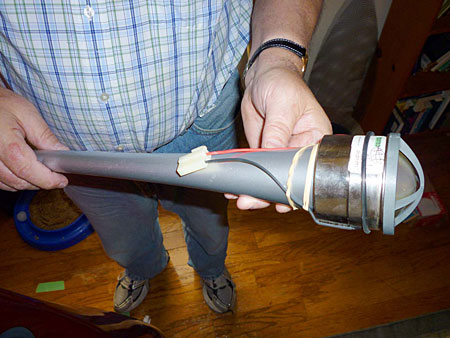| Columns Retired Columns & Blogs |
Dickie? Vivid? Is this a porn double entendre?
 Set vivid, detailed goals
Set vivid, detailed goals
Other than accessing their bottom-mounted, biwirable speaker terminals—a two-person job—the G1Giyas weren't difficult to set up. Their narrow profile favors a slight toe-in, and they like room to breathe; in my room, they ended up 46" from the sidewalls and 71" from the front wall.
The Vivid has a claimed sensitivity of 91dB; I was able to easily drive them with all of the amplifiers I had in-house: Aesthetix Atlas (200Wpc) and Balanced Audio Technology VK-55SE (55Wpc) stereo amps, and Luxman B1000f (250W) and Parasound Halo JC 1 (400W) monoblocks. You'd expect the big monoblocks to have enough grunt to drive almost anything, but even the relatively low-powered BAT drove the Giyas to remarkable levels with no loss of clarity or air. I wouldn't attempt to drive the Vivids with a single-ended-triode design or a low-current solid-state amplifier—but neither, I suspect, would anyone else.
A caution, however: Although the G1Giya's grille is a very open wire mesh, it did muffle the sound to a degree that, while not exactly egregious, affected the speaker's openness and detail more than I could tolerate. On the other hand, the 50mm dome is fragile, and a magnet for curious fingers and god knows what else. Somehow, both midrange drivers wound up dented during their stay at my house—I know I didn't do it, and I don't think any of the adults in the household did either, but I recommend religiously replacing the grilles after every listening session. Fortunately, this is easy to do: they're held in place by magnets within the baffle.
Vivid images are like a beautiful melody
Cold out of their crates, the G1Giyas sounded great: dynamic, open, rich, and, yes, vivid. It turned out that that was how they sounded when literally cold—the temperature outside was in the teens. Within an hour they were sounding more dynamic, open, rich, and vivid. O'Hanlon, Timachev, and I chatted and listened, whiling away the afternoon until John Atkinson arrived and played some of his most recent high-resolution recording projects. Wowsers! My realism meter was pegged at 11!

I was consistently impressed by the G1Giya's dynamic range and jump factor. Then Philip O'Hanlon asked if he could audition some of his own hi-rez digital files. He likes to listen loud. He cranked the Luxman monoblocks into hyperdrive (or at least to somewhere above 100dB). To my surprise, even at extremely high volume levels, the Giyas retained all their clarity and focus—and produced deep bass that immediately set off car alarms in front of my house.
This was indeed impressive performance. I don't typically listen at such a high volume, but I'd never heard a loudspeaker return such a feeling of limitless naturalism. Even at levels that had to be overloading my listening room, there was no sense of imminent—or any—dynamic compression. Not that there can't be dynamic compression from live acoustic music—I've heard the Chicago Symphony Orchestra overload Carnegie Hall—but that sense of limitless ease is one of the ways that live music retains its edge over reproduced sound. It's a quality I've never heard another loudspeaker do better than the G1Giya.

"The Wardrobe Master of Paradise," from The Conjure Project's Conjure (American Clavé, 24-bit/88kHz FLAC download from HDtracks.com), had a soundstage extraordinarily wide and deep. Taj Mahal's gravelly growl had depth and a remarkably lifelike huskiness. David Murray's tenor had bite and startling presence. However, it was the Haitian drummers who stole the show—their drums leapt from the mix with the speed and bite and, especially, the sensation of inhabiting an acoustic space. It was uncannily lifelike. I attended the recording sessions for this album, so I know it was recorded in the old Electric Lady studios—not a large, reverberant venue, though you'd never know it from the sound of this album.
"Ducks on the Wall," from the Kinks' A Soap Opera (Koch International, 24/96 FLAC download, HDtracks), begins with an extremely rude duck call that the G1Giyas delivered with close-to-squarewave nastiness, before breaking into a raucous boogie featuring Dave Davies' cutting guitar and some tasty bass playing from John Dalton. Ray Davies' shouted vocals are very up-front, but overall, A Soap Opera offers solid studio rock sound—that guitar is crisp, and the bass is tight and moderately extended.

Dickie? Vivid? Is this a porn double entendre?